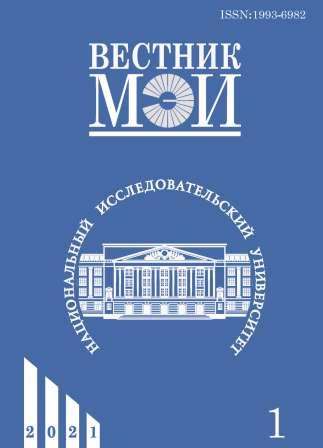An Analysis of Modern Methods for Processing Vat Residues at NPPs
Abstract
To date, more than 600 thousand m3 of liquid radioactive waste has been accumulated at Russian nuclear power plants (NPPs). In addition to radioactive components, they contain a large amount of mineral salts, organic matter, oil products, and suspensions. The problem of overfilling the storage facilities for liquid waste at some NPPs is critical and has to be solved urgently.
The article presents modern methods for processing vat residues and the existing prerequisites for modernizing ion-selective purification plants, which are based on the results of research works carried out by various teams. A technological analysis of the methods for evaporation and ion-selective purification of vat residues with identified shortcomings of individual stages of the technologies is carried out. Decontamination of secondary products of liquid radioactive waste processing implies the possibility of subsequently separating valuable components for reusing them. Their decontamination is necessary, since these wastes are essentially high-salt solutions with a specific activity of 106-107 Bq/l contaminated with fission products, radionuclides of corrosion origin, and various substances used to decontaminate the equipment and maintain the water chemistry. It is proposed to apply the electrodialysis method for separating a multicomponent solution of the decontaminated NPP vat residue and to use the obtained products at the plant. Owing to the partial extraction of valuable components from decontaminated vat residues, it becomes possible to reduce the amount of waste and return the separated substances into the main process cycle, thereby reducing the expenditures for initial reagents. To implement the developed technology for component-wise separation of the initial solution, a laboratory electrodialysis facility was manufactured. The project implementation feature was that in dealing with boric acid salts, it is necessary to take into account the danger of their precipitation at certain pH values. It was found that to minimize the escape of boric components, the process should be conducted at low pH values, i.e., the solution should be acidified with the nitric acid obtained in the process. The obtained study results can be used to modernize the cementation plants.
References
2. НП-093—14. Критерии приемлемости радиоактивных отходов для захоронения.
3. Решение НТС № 10 ГК «Росатом» «Экология и радиационная безопасность» по теме» «Технологические аспекты обеспечения радиационной и экологической безопасности». П. 3 «Обоснование безопасности захоронения солевого плава, образующегося при переработке ЖРО АЭС с РУ ВВЭР-1000».
4. Лагунова Ю.О. Использование озона и перекиси водорода для окислительного разложения органических комплексонов в процессе очистки жидких радиоактивных отходов: автореф. дис. … канд. хим. наук. М.: Институт физ. химии и электрохимии им. А.Н. Фрумкина РАН, 2012.
5. СП 2.6.1.2612—10. Основные санитарные правила обеспечения радиационной безопасности (ОСПОРБ-99/2010).
6. Свитцов А.А., Демкин В.И., Салтыков Б.В. Электромембранный метод утилизации солевых концентратов // Материалы X Междунар. водно-химического форума. М.: НИУ «МЭИ», 2017. С. 42—48.
7. Пилат Б.В. Основы электродиализа. М.: Аввалон, 2004.
8. Нестеров Д.В. Синтез новых бор-хелатообразующих лигандов — производных 3-аминопропандиола-1,2: дис. … канд. хим. наук. Екатеринбург: Изд-во Уральского гос. лесотехнического ун-та, 2018.
---
Для цитирования: Свитцов А.А., Ильина С.И., Иванов С.В., Салтыков Б.В. Анализ современных методов переработки кубовых остатков атомных электрических станций // Вестник МЭИ. 2021. № 1. С. 39—43.
#
1. Postanovlenie Pravitel'stva RF № 1069 ot 19.10.2012 «O Kriteriyakh Otneseniya Tverdykh, Zhidkikh i Gazoobraznykh Otkhodov k Radioaktivnym Otkhodam, Kriteriyam Otneseniya Radioaktivnykh Otkhodov k Osobym Radioaktivnym Otkhodam i k Udalyaemym Radioaktivnym Otkhodam i Kriteriyakh Klassifikatsii Udalyaemykh Radioaktivnykh Otkhodov».(in Russian).
2. NP-093—14. Kriterii Priemlemosti Radioaktivnykh Otkhodov dlya Zakhoroneniya. (in Russian).
3. Reshenie NTS № 10 GK «Rosatom» «Ekologiya i Radiatsionnaya Bezopasnost'» po Teme» «Tekhnologicheskie Aspekty Obespecheniya Radiatsionnoy i Ekologicheskoy Bezopasnosti». P. 3 «Obosnovanie Bezopasnosti Zakhoroneniya Solevogo Plava, Obrazuyushchegosya pri Pererabotke ZhRO AES s RU VVER-1000».(in Russian).
4. Lagunova Yu.O. Ispol'zovanie Ozona i Perekisi Vodoroda dlya Okislitel'nogo Razlozheniya Organicheskikh Kompleksonov v Protsesse Ochistki Zhidkikh Radioaktivnykh Otkhodov: Avtoref. Dis. … Kand. Khim. Nauk. M.: Institut Fiz. Khimii i Elektrokhimii im. A.N. Frumkina RAN, 2012. (in Russian).
5. SP 2.6.1.2612—10. Osnovnye Sanitarnye Pravila Obespecheniya Radiatsionnoy Bezopasnosti (OSPORB-99/2010). (in Russian).
6. Svittsov A.A., Demkin V.I., Saltykov B.V. Elektromembrannyy Metod Utilizatsii Solevykh Kontsentratov. Materialy X Mezhdunar. Vodno-khimicheskogo Foruma. M.: NIU «MEI», 2017:42—48. (in Russian).
7. Pilat B.V. Osnovy Elektrodializa. M.: Avvalon, 2004. (in Russian).
8. Nesterov D.V. Sintez Novykh Bor-khelatoobrazuyushchikh Ligandov — Proizvodnykh 3-Aminopropandiola-1,2: Dis. … Kand. Khim. Nauk. Ekaterinburg: Izd-vo Ural'skogo Gos. Lesotekhnicheskogo Un-ta, 2018. (in Russian).
---
For citation: Svitzov A.A., Ilyina S.I., Ivanov S.V., Saltykov B.V. An Analysis of Modern Methods for Processing Vat Residues at NPPs. Bulletin of MPEI. 2021;1:39—43. (in Russian).




